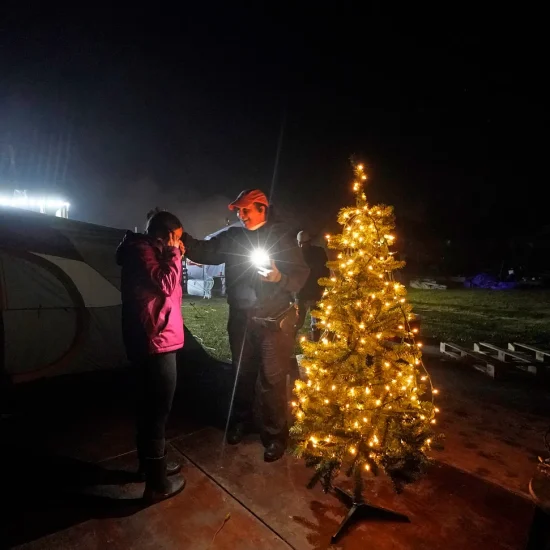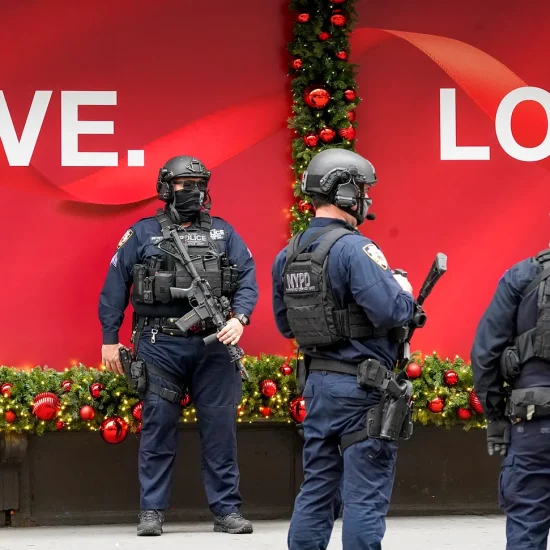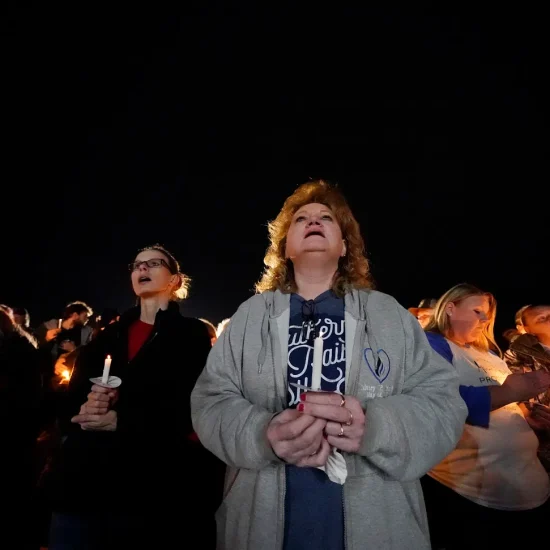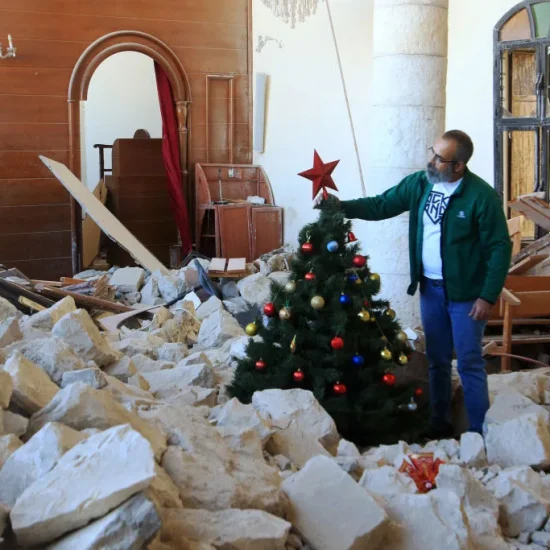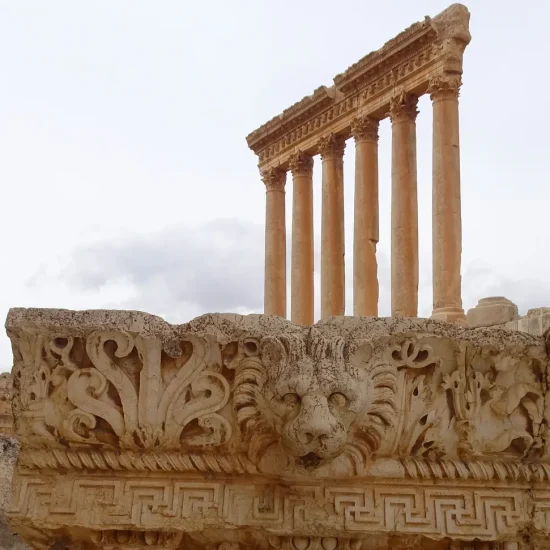On the second Sunday of Advent, the lawn of Highland Baptist Church in Louisville, Ky., will be covered with wooden crosses like one sees in a military cemetery. Each cross — about 75 of them — will represent one person in the community killed in violence during the year. Although the service may not sound like the joyous Christmas songs filling shopping malls and church pageants, Pastor Joe Phelps thinks the service fits perfectly with Advent.
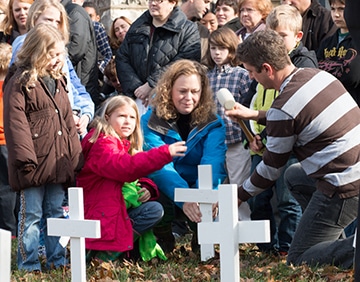 Each year, Highland Baptist Church in Louisville, Ky., covers their lawn with crosses uring Advent. Each cross represents one person in the community killed by violence in the past year.“As a season of waiting and hoping, Advent felt like the natural time to stand against violence and for God’s peace,” he explained. “The second Sunday of Advent is ‘Peace’ Sunday, so it fit easily into our theme for the day. We hope for peace, even as we sit in the darkness and non-yet-ness of Advent.”
Each year, Highland Baptist Church in Louisville, Ky., covers their lawn with crosses uring Advent. Each cross represents one person in the community killed by violence in the past year.“As a season of waiting and hoping, Advent felt like the natural time to stand against violence and for God’s peace,” he explained. “The second Sunday of Advent is ‘Peace’ Sunday, so it fit easily into our theme for the day. We hope for peace, even as we sit in the darkness and non-yet-ness of Advent.”
“We have three Sunday morning services, so one-third of the 75 names of victims will be read in a service,” he added. “As names are read a family or individual is invited to receive the wooden cross for the victim and carry it to the lawn where a grid creates a kind of military cemetery look. You can hear the hammers pounding the crosses into the cold ground even as other names are being read. Hearing the names and ages of our city’s murder victims and reflecting on the sad Christmas their families will have this year reminds us of life’s fragility and the importance of learning our lessons well — that we are one.”
Phelps noted the church started the service nearly two decades ago “to offer a visible witness of solidarity with grieving families of murder victims, as well as to offer a witness to non-violence.” They use 3-foot-tall crosses on the church’s front lawn, which is at a major intersection in the city, to provide a public witness to the community. The church’s marquee announces, “In memory of Louisville’s violence victims this year.” Phelps said the service always attracts local media attention, which allows the church “an opportunity to speak publicly of Advent hope and peace amidst life’s despair and violence.”
“We chose crosses rather than tombstones because the cross is our faith’s central symbol which represents both death and life, despair and hope,” he added. “We hold this event because it feels right and faithful to us, but we also welcome the chance to say to a wider audience, ‘God is not done. Love will win. It just takes time.’”
The most wonderful time of the year?
Rodney Reeves, dean of the Courts Redford College of Theology and Ministry and professor of biblical studies at Southwest Baptist University, sees pain as a key part of the Christmas experience. He noted “the happiest occasions are often marked by dark, difficult times.” Many times “people find the Christmas season to be dreadful,” and those feelings do not come from merely “the demands of shopping and preparing for the holiday.”
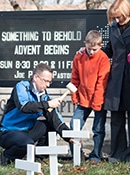 Advent ceremony at Highland Baptist Church, Louisville, Ky.“We are told that many people are depressed during Christmas,” he said. “There are many factors, but I can’t help but wonder whether it’s because we have the ‘Norman Rockwell’ fantasy image in our heads, which defines everything Christmas should be: warm feelings, families reunited in peace, the world in harmony, even cuddly animals that are on Christmas cards that we usually try to catch in traps (mice!).”
Advent ceremony at Highland Baptist Church, Louisville, Ky.“We are told that many people are depressed during Christmas,” he said. “There are many factors, but I can’t help but wonder whether it’s because we have the ‘Norman Rockwell’ fantasy image in our heads, which defines everything Christmas should be: warm feelings, families reunited in peace, the world in harmony, even cuddly animals that are on Christmas cards that we usually try to catch in traps (mice!).”
Reeves finds similar sentimental glossing occurring in the way the biblical narratives are recalled.
“We think such sentiments are anchored by the nativity scenes we’ve conjured up based on a few of the details surrounding Jesus’ birth: shepherds, manger, angels, the holy family, Magi bearing expensive gifts, the Christmas crèche, etc.,” he added. “But that’s only half of the story, primarily Luke’s version with the one detail from Matthew (Magi bearing gifts) thrown in due to our commercial way of life.”
“Perhaps, the way we celebrate Christmas says more about us than it does about the birth of Jesus,” he explained. “For we ignore the rest of Matthew’s story which is equally important: Jesus was a refugee, seeking asylum from a wicked king who was out to kill him and all the other messianic ‘threats’ to his throne. So, part of the Christmas story — even with all of the violent imagery and disquieting storyline of refugees and weeping mothers — needs to be remembered, too. For even when God sent His Son to save the world, evil showed up and tried to ruin everything.”
Phelps also sees the violence in the biblical Christmas story as a meaningful part of the narratives. For him, the special service on the second Sunday of Advent fits with the biblical message.
“The initial response was critical from older members who felt this ritual was incongruent with the joy of the season,” he said. “This became a teachable moment, as we considered the violence in and around the original Christmas story.”
“Seventeen years later, the crosses ceremony is a treasured tradition which has a unique twist each year that we do it,” he added. “Often a member will be connected with at least one of the victims through work or school or family connections.” This year, for instance, a victim’s name will be read who was allegedly murdered by a young man who sat in Highland’s service two days before the murder. Members of the church now visit the accused murderer regularly in the jail as he awaits trial.
Reeves thinks a focus on the biblical Christmas texts that seem darker can help churches recognize the need to “take care of refugees — the homeless and the poor.”
“For our Savior was once a refugee in Egypt, and his family needed the expensive gifts of the Magi to survive,” he added. “God loves to show up in the darkest of days in the most peculiar ways. So, let us keep our eyes open for the work of God. For Jesus said, when we take care of the ‘least of these,’ we take care of Him.”


